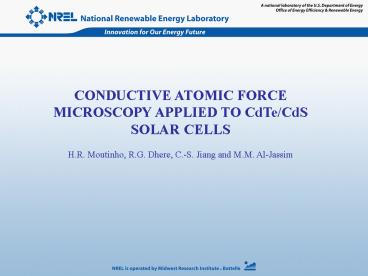Communications: NREL PowerPoint Presentation Template with Light Background PowerPoint PPT Presentation
1 / 31
Title: Communications: NREL PowerPoint Presentation Template with Light Background
1
CONDUCTIVE ATOMIC FORCE MICROSCOPY APPLIED TO
CdTe/CdS SOLAR CELLS H.R. Moutinho, R.G. Dhere,
C.-S. Jiang and M.M. Al-Jassim
2
OBJECTIVES
- Demonstrate the applicability of C-AFM to study
CdTe/CdS solar cells, investigating and
identifying limitations, problems, and advantages
of this technique.
- Study the effects of the standard etching
processes on the electrical properties of
CdTe/CdS devices.
3
INTRODUCTION
- C-AFM uses the probe of an AFM to contact the
sample surface, and measures the current through
a sample for a given applied potential.
- Main advantage High spatial resolution (down to
10 nm, but highly dependent on the sample).
- Provides current images simultaneously with
topographic images.
- Provides I-V curves.
- Specially suitable to find micro shunting in
solar cells.
- Contact between tip and sample may be a problem.
- Can be destructive.
4
(No Transcript)
5
(No Transcript)
6
EXPERIMENTAL PROCEDURE
- Sample Structure glass\SnO2\CdS\CdTe.
- Deposition Standard NREL CSS CdTe and CBD CdS.
- Treatment CdCl2 vapor 400C/5 min.
- Etching 0.5 bromine in methanol solution (BM
etch), for 2 seconds, or phosphoric acidnitric
aciddeionized water (88135) solution (NP
etch), for 30 to 45 seconds.
- C-AFM Digital Instruments DI 3100, using
doped-diamond coated tips.
7
Effect of the force exerted by the tip on the
sample surface.
Ftip 1.2x10-7 3.4x10-7 N
8
Ftip 1.2x10-7 3.4x10-7 N
9
Decrease in current with time.
10
Decrease in current with time.
11
Forward
Reverse
I-V curve for an as-deposited CdTe/CdS solar cell.
12
As-deposited
- No significant effects of topography.
- Different grains have different currents
(electric conductivity).
- No grain boundary effects.
13
CT273cl.013
Vdc 4 V
CdCl2 treated
- Different grains have different currents.
- No grain boundary effects.
- No significant effects of CdCl2 treatment.
14
CT174cl-br.011
Vdc 8 V
After bromine/ Methanol etch
- Different grains have different currents.
- Strong grain boundary effects.
15
CT174cl-br.011
Vdc 8 V
16
Vdc 5 V
17
Vdc -5 V
18
After NP etch
- Magnitude of the current increases significantly.
- Loss of spatial resolution.
- Current image is not uniform.
19
- I-V curve ohmic behavior.
20
CT252cl-nps-b
0.6
0 mV
0.4
-300 mV
0.2
-665 mV
I (mA)
-500 mV
0
-0.2
0
0.5
0
0.5
0
0.5
0
0.5
0
0.5
1
Distance (mm)
Linescans for sample illuminated with white light
and biased under different voltages
21
CT340b.001
After NP etch
X-C-AFM
22
CT340d.005
After bromine/methanol etch
X-C-AFM
23
CT340b.007
After NP etch
X-C-AFM
24
CONCLUSIONS
- We demonstrated the application of C-AFM to the
study of CdTe/CdS solar cells.
- As-deposited Grains with different currents,
indicating differences in electric conductivity.
- CdCl2 treatment No significant differences.
- BM etch Relative increase in current at grain
boundaries, due to Te-rich layer at these regions.
- NP etch Increase in current over the entire CdTe
surface (Te-rich surface layer), change in the
electric contact between the tip and the sample
surface from rectifying to ohmic, and
photocurrent.
- X-C-AFM higher penetration for the np etch and
capability of the technique to detect shunts in
the device.
- For our treatment conditions, NP etch is more
suitable for use as back contact in CdTe/CdS
solar cells.
25
FUTURE WORK
Surface and Cross-Section
- Study the effect of changing the dipping time
for both, NP and bromine solutions, to optimize
the etching process.
Cross-Section
- Study the effect of using different back
contacts (Au-Cu and ZnTe).
26
CT250cl-br2s.009 CT250cl-br2s.013
Linescan
27
B129ad
I-V curves for different tip forces.
28
CT273cl-np
Strong white light
Room light
No (intentional) illumination
29
Vdc 1 V
30
Vdc -3 V
31
(No Transcript)

